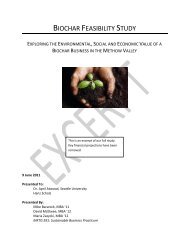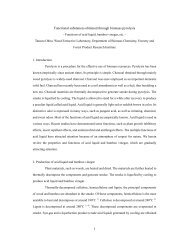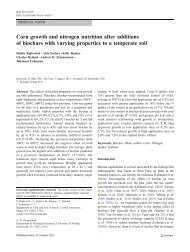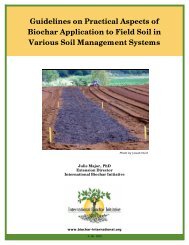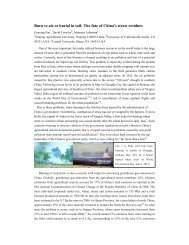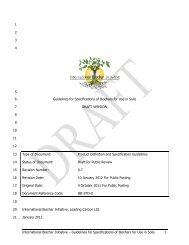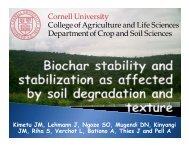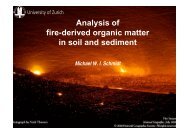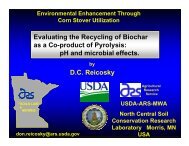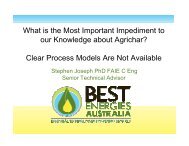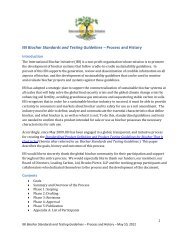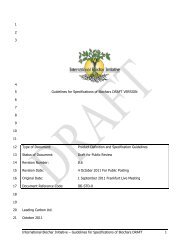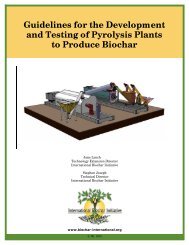Poultry Litter Biochar â a US Perspective - International Biochar ...
Poultry Litter Biochar â a US Perspective - International Biochar ...
Poultry Litter Biochar â a US Perspective - International Biochar ...
Create successful ePaper yourself
Turn your PDF publications into a flip-book with our unique Google optimized e-Paper software.
<strong>Poultry</strong> <strong>Litter</strong> <strong>Biochar</strong> – a <strong>US</strong> <strong>Perspective</strong>Updated June 2012By Kathleen Draper and Thayer TomlinsonThis paper outlines the specific characteristics of poultry litter (PL) biochar based on existing researchand literature, a limited number of demonstration projects in the <strong>US</strong>, and the potential marketopportunities for this type of biochar. It highlights the general characteristics of PL biochar, the benefitsof PL biochar production, the challenges for farmers, the uses for PL biochar (outside a soilamendment), and the alternative uses for poultry litter.<strong>Biochar</strong><strong>Biochar</strong> is a solid material obtained from the carbonisation of biomass and may be added to soils withthe intention to improve soil functions and to reduce greenhouse gas (GHG) emissions from thedecomposition of biomass. <strong>Biochar</strong> is produced from intentionally heating a biomass feedstock viapyrolysis or gasification, typically in an oxygen limited environment, with the goal of creating a stable,carbon‐rich product resistant to degradation in soils.<strong>Biochar</strong> is actually a spectrum of materials with certain characteristics, depending on how it is produced,and the feedstock that is used. Various agricultural waste products can be converted into biocharincluding forestry, crop waste, and animal manures. The choice of feedstock significantly impacts thebiochar product and its uses. Specific production parameters (including temperature, residence time,rate of temperature increase, pre‐ and post‐processing, among others) also affect the resultingattributes and quality of the biochar, and can impact the nutrient availability to crops, the physical andchemical properties of the biochar, and the amount of stable carbon sequestered. Depending on theproduction parameters, more than 50% of the organic material’s carbon may be sequestered in a stableform in the biochar. When the biochar is used as a soil amendment, a significant proportion of therecalcitrant biochar carbon can resist degradation for hundreds to even thousands of years, thuscreating stable carbon pools.Other significant benefits of biochar include improved soil fertility, crop productivity, water retention incertain types of soils, the reduced need for additional fertilizer usage, and reduced nutrient leaching. Inaddition, bio‐fuels and process heat can be created during the production process.<strong>Poultry</strong> <strong>Litter</strong> <strong>Biochar</strong><strong>Poultry</strong> farming is a high volume enterprise in a number of areas throughout the U.S. Concentratedpoultry farms produce large amounts of poultry litter, which can create waste management challenges.<strong>International</strong> <strong>Biochar</strong> Initiative; June 2012
At this time, more litter is being produced than the industry is able to utilize effectively. Currently, theprimary use of poultry litter in the <strong>US</strong> is as fertilizer for pasture, hay, small grains, and corn‐producingfields (Atul and English, 2005). Additional strategies to effectively deal with this waste product currentlyexist, however poultry litter biochar offers a number of unique benefits.<strong>Poultry</strong> <strong>Litter</strong> (PL) biochar is made from chicken manure and the bedding used in poultry operations—wood shavings, saw dust, straw or other organic materials—as well as feathers, feed spillage andmortalities. Some characteristics of PL biochar that differ from plant‐based biochars include:Higher nutrient content, especially nitrogen and phosphorous (Van Zwieten, 2009). Although theamount of Nitrogen (N) conserved after pyrolysis is lower for PL versus other feedstocks, thehigh initial nutrient content ensures that the resultant amount is still significantly higher overall.(Gaskin et al, 2008).Higher cation‐exchange capacity (CEC) with lower temperature pyrolysis. A recent study on CECand PL biochar showed a significantly higher CEC in low temperature (400 degrees C) poultrylitter biochar than in peanut hull and pine chip biochars at the same temperature (Gaskin et al,2008).Significantly greater ability to adsorb and sequester metal ions (for cleaning mine‐tailings andother toxic sites) over plant‐based biochars (Lima et al 2009).Higher ash content which is useful particularly for low pH soils as a liming agent; a study by Daset al 2008 highlighted PL biochar with an ash content of 26% versus ash content of approx 2%from pine chip derived biochar.Correspondingly, the pine chip biochar from the Das et al 2008 study contained 84% carbonwhereas the PL biochar contained 62%.Benefits of PL <strong>Biochar</strong> ProductionThe production of biochar from poultry litter offers many potential benefits to farmers—especially ifthat production occurs onsite. Specific benefits to the producer/farmer may include:Reduced heating fuel requirements due to excess heat from the biochar production process(pyrolysis or gasification); heat from the unit may be used directly onsite to heat bird housesand other production/processing facilities.Reduced cost to dispose of poultry litter (applicable in areas of highly concentrated poultryoperations where nutrient overload is causing environmental hazards such as the ChesapeakeBay; see Covell et al 2011).Reduced nutrient run off from alternative uses such as direct land application. PL biochar,especially when mixed with compost prior to field application, can help retain nutrients in thesoil which might otherwise be lost (Steiner et al, 2010).Potential to use the biochar onsite for increased crop productivity, and/or mixed with poultrylitter compost to reduce nitrogen loss (Steiner et al, 2010).Potential for added income from selling biochar to a local market or a distributer. Currentlysome <strong>US</strong> poultry farmers are able to trade their poultry litter to those involved in pelletizationfor litter disposal services but do not earn any additional income.<strong>International</strong> <strong>Biochar</strong> Initiative; June 2012
Reduced liability related to pollution when farmers retain poultry litter for extended periods(e.g. they have too much of it and cannot dispose of it in a timely manner).Challenges for Farmers in Producing <strong>Poultry</strong> <strong>Litter</strong> <strong>Biochar</strong>Connecting biochar product/producers to under‐developed biochar markets. Consistent moisture content: a biochar feedstock should optimally be in range of 0% – 35%moisture; poultry litter with a higher moisture content would normally require drying prior topyrolysis or gasification.Competing with alternative uses for the product which may not have the initial production costsof biochar.Loss of N with pyrolysis; however, studies have shown that if biochar is added to poultry littercompost, the biochar can reduce Nitrogen losses (Steiner et al, 2010).Capital investment required by the farmer for an onsite pyrolysis processing facility or fortransportation to an offsite processing facility.<strong>Biochar</strong> production can distract from the core business of the farmer/producer.The onus to meet local/regional air emissions requirements, and any work place health andsafety requirements associated with the biochar production process is on the farmer.With biochar as the intended end use, farmers may have to limit or omit use of food additivesthat can be passed into the manure and concentrated in the biochar (e.g. arsenic).May limit the farmer’s source of bedding material as the pyrolysis process may not be designedto process all feedstocks.Uses for PL <strong>Biochar</strong> other than as a Soil Amendment<strong>Biochar</strong> is generally defined and understood as a product intended to be added to soils as anamendment. Some uses as highlighted below may utilize biochar for a similar purpose, while others suchas bio‐filtration and as an activated carbon substitute may not intend necessarily for the product to beadded to soils.Storm Water Treatment: Although some other feedstocks appear to provide stronger waterretention capabilities, PL biochar binds certain toxic chemicals such as copper, cadmium and zinc(Comis, 2010). The combination of both of these benefits makes PL biochar an attractive solution forstorm water treatment areas which are becoming mandatory in many areas around the country toimprove water quality and ease the burden on public water treatment systems.Reforestation efforts on reclaimed mined lands: Significant numbers of former mines wereabandoned once the target minerals were extracted, leaving behind damaged landscapes,contaminated waterways and reduced biodiversity. Research on the use of biochar as a lower‐cost,higher impact remediation technique has been done in both Colorado (Hansen, 2011) and WestVirginia (WVU Environmental Research Center, 2011 and Todd et al, 2010), and additional researchis underway domestically and internationally. Given that PL biochar is higher in certain nutrients andthat it has strong filtration and binding characteristics, PL biochar may be a strong contender forremediation projects around the country.<strong>International</strong> <strong>Biochar</strong> Initiative; June 2012
Reduction of nitrogen loss in poultry litter compost: <strong>Poultry</strong> litter compost is often used as anatural fertilizer due to high levels of Phosphorous (P), Potassium (K), N and other micronutrients.During the composting process significant amounts of N can be lost. However research has shown(Steiner et al, 2010) that when combined with biochar the loss is reduced by up to 52% andammonia emissions reduced up to 64% using an 80/20 poultry litter/biochar mix. This testing wasdone with non‐PL biochar (made from pine chips) so results may vary. The ability to combine poultrylitter with PL biochar offers reduced transportation advantages as the mixing can be done at a singlelocation.Livestock Operation Bio‐filtration ‐ odor abatement & removal of air pollutants: Large scale animalproduction facilities can emit significant amounts of air pollutants and strong odors. Tests done bythe <strong>US</strong>DA Agricultural Research Service (ARS) and Western Kentucky University demonstrated that acombination of PL biochar and poultry litter were effective in reducing ammonia emissions by morethan 90%—highlighting that biochar could be used to reduce ammonia emissions in livestockproduction facilities (Lovanh et al, 2010).Tradable asset for nutrient trading programs: At least one major area of the U.S. has a growingnutrient trading program aimed at curbing excess nutrients which are impacting important bodies ofwater. The Chesapeake Bay nutrient trading program which currently spans parts of Virginia andPennsylvania, Maryland and West Virginia is focused on reducing N and P. This trading program issimilar to a GHG cap & trade system. Heavy generators of N and P such as wastewater treatmentplants with large emissions must purchase offsets from qualified nutrient sellers such as farmersthat implement certain conservation measures that reduce nutrient loads.Activated Carbon Substitute: Similar to the market for storm water treatment and rain gardens, agrowing market exists for the functions served by activated carbon (AC). It is anticipated that <strong>US</strong>regulations may be passed in the short term related to reducing mercury emissions from coal firedplants as well as limitations on releases of ammonia. Should these types of regulations pass, themarket for AC could be very large. PL biochar has been found to be more effective than otherfeedstocks used to create activated carbon (e.g. coal, coconut shells), is generally cheaper toproduce (Lima, Coble, Klasson, & Uchimiya 2010), and is a renewable alternative with large suppliesin various regions throughout the <strong>US</strong>.The <strong>US</strong>DA has patented a process for creating AC from poultry litter using slow pyrolysis followed byacid washing (Lima, Marshall 2009). The post‐processing (acid wash) step increases the surface areaof the biochar and neutralizes the high calcium and phosphorus found in PL biochar. The <strong>US</strong>DA hasan interest in licensing the patent for commercial use.Alternative uses for <strong>Poultry</strong> <strong>Litter</strong>Existing uses for poultry litter include land application, pelletization, compost and litter‐to‐energy. Abrief look at each of these uses including some of their limitations is provided below.Land application is the most common use of PL by farmers (Dunkley et al, 2011). However issuesof over‐application, especially in watershed areas, are beginning to be regulated.Composting is perhaps the most similar to PL biochar in terms of soil amendment benefits,although producing PL compost can take much longer and depending on the compostingprocess used, could be more labor intensive. Additionally, methane emissions from composting,coupled with biochar’s longer term soil benefits and stable carbon sequestration, may makebiochar production a more attractive option. Producing biochar from poultry litter will reduce<strong>International</strong> <strong>Biochar</strong> Initiative; June 2012
the material mass—the same amount of poultry litter in biochar form will weigh much less thanin compost form—therefore the transportation footprint is smaller. However, the transport ofbiochar may be classified as a dangerous good due to possible ignition issues, making transportpotentially more expensive. On a large scale, PL biochar production requires a larger capitalinvestment compared to composting. On the plus side, PL biochar production producessignificantly less odor than composting and provides better bio‐security as pyrolysis neutralizespathogens (especially with mortalities).If the manure is pelletized, the litter is dried and pasteurized to create pellets and granularfertilizer. Generally farmers are provided with clean out and hauling services in exchange fortheir litter but typically make little income on the litter.The use of poultry litter for electricity generation faces significant challenges due to poorenvironmental/air quality track records of some companies that have been cited and fined forexcess nitrogen oxide, sulfur dioxide and carbon monoxide emissions (Minnesota PollutionControl Agency, 2009). Large scale poultry litter biochar production may face regulatorychallenges due to this.The technology for producing heat for poultry houses from woody biomass is more advancedwith fewer technical issues than PL biochar gasifiers. Where woody biomass is easily available, itmay be more economic to compost wood‐based biochar with the PL to make a carbon andnutrient‐rich compost for sale, while using the process heat to warm the poultry houses.There are a few, but a growing number of farming operations in the <strong>US</strong> that are using poultry litter forbiochar production. As more information is known about the benefits and costs of using this feedstockto produce biochar, farmers will have a better sense of whether or not PL biochar will be a goodinvestment for them.IBI recently engaged in a process to produce specification guidelines for characterizing biochar entitledThe Standardized Product Definition and Product Testing Guidelines for <strong>Biochar</strong> That Is Used in Soil. IBIbegan the process of establishing the <strong>Biochar</strong> Standards in May 2009 as a critical first step for thecommercialization of sustainable biochar systems. The <strong>Biochar</strong> Standards provide the tools needed touniversally and consistently define what biochar is, and to confirm that a product intended for sale oruse as biochar possesses the necessary characteristics for safe use. Work is ongoing to develop methodsto match different types of biochar to soils to study how PL biochars will react to local soils. For moreinformation on the <strong>Biochar</strong> Standards please see:http://www.biochar‐international.org/characterizationstandard.References:Agblevor, Foster A, D. Grysko, K. Revelle (Oct. 11, 2010). Pyrolysis Technology: Environmentally friendlysolution to nutrient management in the Chesapeake Bay. Presentation at Chesapeake Goal Line 2025Presentation, Hunt Valley, MD.Comis, Don (2010), Better Ballfields and Rain Gardens Start Below the Surface. Agricultural ResearchMagazine. November/December 2010 ‐ Vol. 58, No. 10.Phil Covell, Gena Gammie, Suzanne Hunt, Lopa Brunjes, Fai Ng, Dan Nees (2011). Advancing <strong>Biochar</strong> inthe Chesapeake: A Strategy to Reduce Pollution from <strong>Poultry</strong> <strong>Litter</strong>. Forest Trends/Katoomba Incubator,<strong>International</strong> <strong>Biochar</strong> Initiative; June 2012
Carbon War Room, Forest Trends/Chesapeake Fund. Available at:http://www.forest‐trends.org/publication_details.php?publicationID=2891.Das, K. C., Garcia‐Perez M., Bibens B., and Melear N. (2008). Slow pyrolysis of poultry litter and pinewoody biomass: Impact of chars and bio‐oils on microbial growth. Journal of Environmental Science andHealth Part A‐Toxic/hazardous Substances & Environmental Engineering, Volume 43(7), p.714‐724.Dunkley, Claudia S., Cunningham, Dan L., Harris, Glendon H. (2011). The Value of <strong>Poultry</strong> <strong>Litter</strong> in SouthGeorgia. University of Georgia.Gaskin, J. W., Steiner C., Harris K., Das K. C., and Bibens B. (2008). Effect of low‐temperature pyrolysisconditions on biochar for agricultural use. Transactions of the Asabe. Volume 51(6), p.2061‐2069.Hansen, Heather. New hope for old mines. High Country News. January 12, 2011; at:http://www.hcn.org/blogs/range/new‐hope‐for‐old‐mines.Lima, Isabel, Akwasi A. Boateng, and K. Thomas Klasson (2009). Pyrolysis of Broiler Manure: Char andProduct Gas Characterization. Ind. Eng. Chem. Res. 2009, 48, 1292–1297.Lima, Isabel, Marshall, Wayne E. (2009). <strong>US</strong> Patent # 7,524,795. Found at:http://patft.uspto.gov/netacgi/nph‐Parser?Sect1=PTO1&Sect2=HITOFF&d=PALL&p=1&u=%2Fnetahtml%2FPTO%2Fsrchnum.htm&r=1&f=G&l=50&s1=7,524,795.PN.&OS=PN/7,524,795&RS=PN/7,524,795Lima, Isabel, Coble, Christina, Klasson, K.T. & Uchimiya, Minori (2010). Effect of nitrogen flow rate onthe physico‐chemical and adsorptive properties of a broiler manure bio‐char. Conference presentationat <strong>US</strong>BI, Ames, IA.Lovanh, N.C., Loughrin, J.H., Sistani, K.R. (2010). Abiotic and Biotic Effect of <strong>Poultry</strong> <strong>Litter</strong> <strong>Biochar</strong> onAmmonia Removal. Conference abstract at <strong>US</strong>BI, Ames, IA.Minnesota Pollution Control Agency (2009). Fibrominn Power Plant Cited for Alleged Air EmissionsViolations. Press Release Sunday, December 20, 2009.Sheth, Atul C. and Jennifer English (2005). Preliminary Economic Analysis of <strong>Poultry</strong> <strong>Litter</strong> GasificationOption with a Simple Transportation Model. Journal of Air and Waste Management. Volume 55. Pages510 – 522.Steiner, Christoph, Das K. C., Melear Nathan, and Lakly Donald (2010). Reducing Nitrogen Loss during<strong>Poultry</strong> <strong>Litter</strong> Composting Using <strong>Biochar</strong>. Journal of Environmental Quality, 02/2010, Volume 39.Todd, John, Samir Doshi, Anthony McInnis (2010). Beyond coal: A resilient new economy for Appalachia.Solutions. Volume 1: Issue 4: Page 45‐52.Van Zwieten, Lukas (2009). Agro‐economic valuation of biochar using field‐derived data. Conferencepresentation at Asia Pacific <strong>Biochar</strong>, May 2009, Gold Coast Australia.WVU Environmental Research Center (2011). Turning <strong>Poultry</strong> <strong>Litter</strong> into a Stewardship Asset. WVUEnvironmental Research Center Winter 2011 Newsletter. Issue 2; at:http://erc.davis.wvu.edu/news/current_newsletter/biochar.<strong>International</strong> <strong>Biochar</strong> Initiative; June 2012



